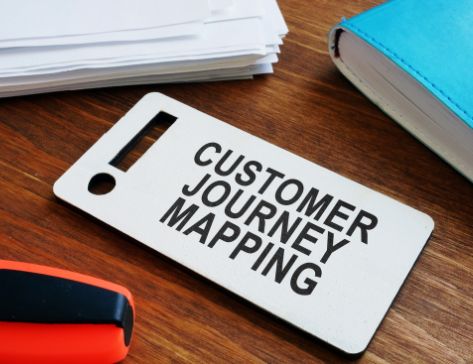
Understanding Customer Journey Maps Through Data Analytics: A Comprehensive Guide
This comprehensive guide delves into the critical process of understanding Customer Journey Maps Data Analytics, revealing how quantitative insights transform hypothetical paths into validated, actionable blueprints for enhancing customer experience. Traditionally, customer journey maps were often crafted based on personas, anecdotal evidence, and internal assumptions. While valuable for empathy building, these maps lacked the empirical grounding needed to pinpoint precise friction points, identify true behavioral patterns, and measure the impact of optimizations. By integrating robust data analytics, businesses can illuminate the actual paths customers take, understand their motivations at each stage, and make informed decisions to improve every interaction.

From Assumptions to Evidence: The Power of Data
Traditional customer journey maps typically visualize the stages a customer persona goes through (Awareness, Consideration, Purchase, Retention, Advocacy), outlining potential touchpoints, actions, thoughts, and feelings. However, without data validation, these remain largely hypothetical. Data analytics injects reality into the map. It allows you to see *how many* customers actually follow a specific path, *where* they drop off, *how long* they spend at certain stages, and *which* touchpoints are most influential. This shift from assumption-based mapping to evidence-based analysis is fundamental. Utilizing customer journey analytics platforms and techniques allows businesses to quantify the customer experience, identify statistically significant patterns, and prioritize improvements based on real-world impact rather than guesswork.
Key Data Sources for Journey Mapping Analytics
Building a data-driven customer journey map requires gathering and integrating information from diverse sources across the customer lifecycle:
- Web & App Analytics: Platforms like Google Analytics 4 provide data on traffic sources, landing pages, user flow through the site/app, time spent on pages, bounce rates, conversion paths, event tracking (e.g., button clicks, video views), and audience demographics/technology.
- CRM Data: Customer Relationship Management systems track lead sources, sales interactions, purchase history, customer service records, contact information, and overall customer value.
- Social Media Analytics: Insights into brand mentions, sentiment, engagement with posts, follower demographics, and referral traffic from social channels.
- Email Marketing Platform Data: Metrics like open rates, click-through rates (CTR), conversion rates from email campaigns, unsubscribe rates, and engagement with specific email content.
- Customer Feedback & Surveys: Direct input via Net Promoter Score (NPS), Customer Satisfaction (CSAT) surveys, reviews on third-party sites, usability testing feedback, and direct interviews provide qualitative context and sentiment data.
- Support & Call Center Data: Information on common issues, resolution times, support channel usage (chat, phone, email), and customer sentiment expressed during support interactions.
- Transactional Data: Details on products purchased, order frequency, average order value (AOV), cart abandonment rates, and usage of discount codes.
Steps to Build Customer Journey Maps with Data Analytics
Creating an effective, data-informed journey map involves a systematic process. This process is often enhanced by incorporating insights from predictive marketing techniques, which can forecast likely next steps or potential friction points based on existing data patterns.
Step 1: Define Goals and Scope
Start by clarifying the purpose of your map. Are you trying to understand the onboarding process, the path to first purchase, the support journey, or the entire customer lifecycle? Define which specific customer segment or persona the map will focus on. Clear goals prevent the map from becoming too broad and ensure the analysis is focused.
Step 2: Identify Key Stages and Touchpoints
Outline the major stages your chosen customer segment typically goes through (e.g., Awareness, Research, Comparison, Purchase, Post-Purchase Engagement). Then, brainstorm all potential touchpoints where customers might interact with your brand within each stage (e.g., social media ad, blog post, website visit, email newsletter, sales call, support chat, review site).
Step 3: Collect and Integrate Relevant Data
Gather data from the sources identified earlier (web analytics, CRM, etc.) corresponding to each touchpoint and stage. This is often the most challenging step. Tools like Customer Data Platforms (CDPs) can help integrate data from disparate systems to create a unified customer view. Ensure data quality and consistency.
Step 4: Analyze Data for Each Journey Stage
This is where the “analytics” part truly happens. Analyze the integrated data to understand customer behavior at each stage:
- Awareness: Which channels drive initial discovery (organic search, paid ads, social media)? What are the top landing pages?
- Consideration/Research: Which content pieces are most engaged with? How long do users spend comparing products/features? What paths do they take through the website?
- Decision/Purchase: What are the conversion rates for different paths? Where do users abandon carts or forms? Which touchpoints are most common just before conversion (attribution)?
- Retention/Loyalty: What is the frequency of repeat purchases? How often do customers engage with post-purchase content or support? What behaviors correlate with higher lifetime value?
- Advocacy: Which customers leave reviews or refer others (tracked via referral codes or surveys)? What characteristics do advocates share?
Look for common pathways, drop-off points, time spent at each stage, and correlations between behaviors and outcomes.
Step 5: Visualize the Data-Driven Journey Map
Translate your findings into a visual map. Unlike purely qualitative maps, incorporate key data points directly onto the map. This could include conversion rates between stages, volume of customers taking a specific path, average time spent, or key pain points identified through high drop-off rates or negative feedback sentiment. Use visualization tools (dedicated CJM software, BI dashboards, or even tools like Miro/Lucidchart supplemented with data annotations).
Step 6: Identify Pain Points, Moments of Truth, and Opportunities
Use the visualized data to pinpoint specific areas of friction (e.g., high bounce rate on a key landing page, complex checkout process, long support wait times). Identify “moments of truth” – critical touchpoints that heavily influence the customer’s decision or overall perception. Highlight opportunities for improvement, personalization, or proactive engagement based on the data.
Step 7: Implement Changes, Test, and Iterate
The map is not a static document. Use the insights gained to implement changes aimed at improving the customer experience at identified pain points or leveraging opportunities. This could involve redesigning a webpage, simplifying a form, adding clearer calls-to-action, personalizing email sequences, or improving support resources. Crucially, A/B test changes where possible and continuously monitor data to measure the impact and further refine the journey.
Tools for Customer Journey Map Data Analytics
- Data Collection: Google Analytics 4, CRM systems (Salesforce, HubSpot), Social Media Analytics tools, Survey Platforms (SurveyMonkey, Typeform), Heatmapping tools (Hotjar).
- Data Integration: Customer Data Platforms (CDP) like Segment, Tealium.
- Data Analysis & Visualization: Business Intelligence (BI) tools (Tableau, Power BI, Looker Studio), specialized Customer Journey Analytics platforms (Qualtrics, Sprinklr), Web Analytics path analysis features.
- Mapping Visualization: Miro, Lucidchart, Smaply, UXPressia.
Challenges in Data-Driven Journey Mapping
- Data Silos: Difficulty integrating data from various disconnected systems.
- Data Quality & Completeness: Inaccurate or missing data can skew analysis.
- Attribution Complexity: Accurately attributing conversions or actions to specific touchpoints in a multi-channel journey is challenging.
- Required Skills: Teams need analytical skills to interpret data and technical skills to manage tools and integrations.
- Privacy Compliance: Ensuring all data collection and usage complies with regulations like GDPR/CCPA.
“You can’t improve what you don’t measure.” – Peter Drucker. Data analytics provides the measurement needed to truly understand and improve the customer journey.
Conclusion: Illuminating the Path Forward
Integrating Customer Journey Maps Data Analytics transforms a valuable conceptual tool into a powerful engine for strategic decision-making and customer experience optimization. By grounding journey maps in real behavioral data, businesses gain unparalleled visibility into how customers truly interact with their brand, where they encounter friction, and what drives success. This data-driven approach enables targeted improvements, efficient resource allocation, and ultimately, the creation of more seamless, satisfying, and profitable customer experiences. Understanding these journeys is also crucial for optimizing advertising efforts, ensuring that campaigns, such as those involving native advertising, reach the right audience at the right stage with the right message, guided by actual user behavior rather than assumptions.


